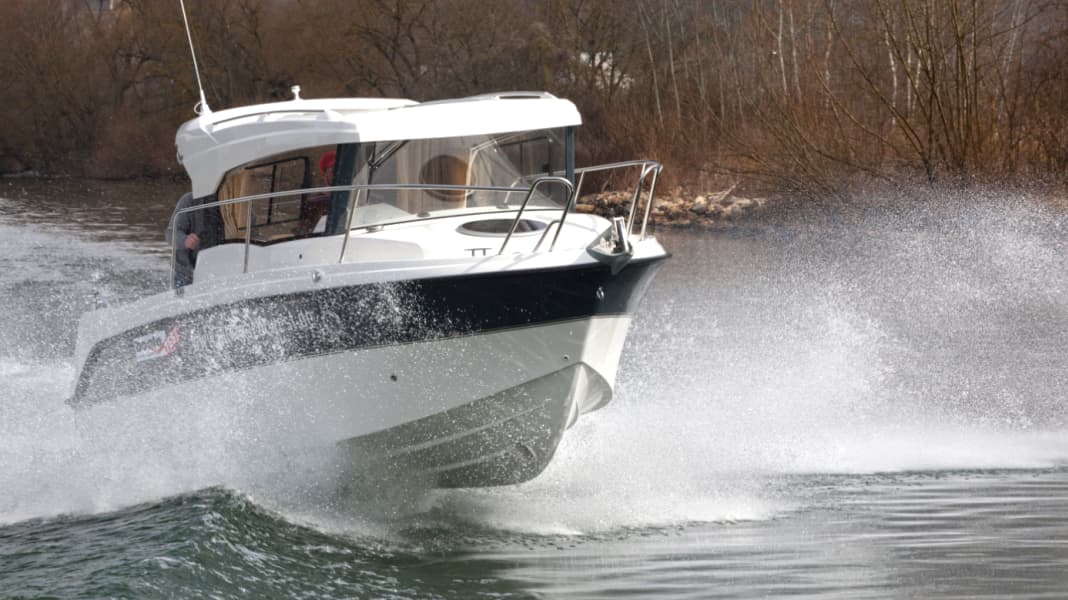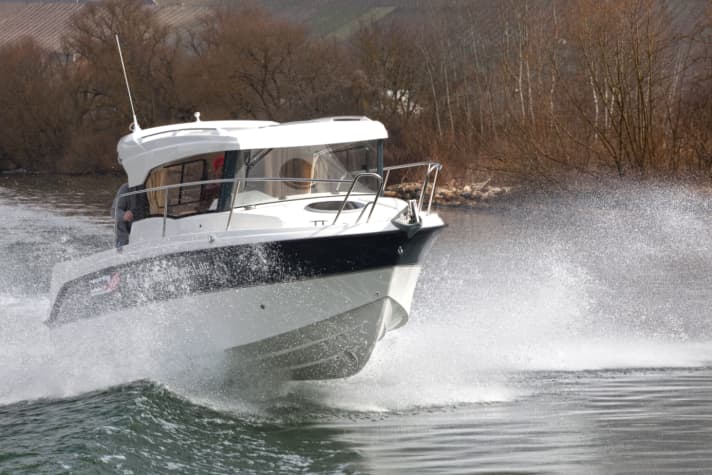







Commercially used boats are pushed hard and have to withstand a lot, so the hull moulds are adapted to the requirements. Parker Poland has been building boats for commercial use since the 1970s. The shipyard's customers include authorities such as the police, fire brigade, border patrol, navy and intelligence services. The Polish shipyard now produces four models in two different lengths for entry-level leisure boating.
Our 6.60 metre test boat has two driving positions, a pantry block, separate toilet room and four berths. The latter are divided into a bow and saloon double berth. The Parker is designed for amateur anglers and water sports enthusiasts who want to spend time on the water with friends or family.
The shipyard specifies two CE categories as sailing areas: firstly, "C" for coastal waters; secondly, the boat can travel outside coastal waters, which corresponds to "B". There are differences in the permitted number of people or payload. For example, a maximum of 6 crew or 880 kg may be on board in category B waters. If you are travelling in coastal waters, one person or 70 kg more may be loaded on board.
At the stern of our test boat, the new Mercury F150 EFI provides propulsion. With its 150 hp, the boat has reached the upper permitted power limit. We were able to log a top speed of exactly 32 knots. A three-blade Mirage Plus 15 P propeller was fitted. When reading the instruments, the engine was turning 5050 rpm at this speed - too low a value given the full-load speed range of 5000-5800 rpm and the low test weight of two people and around 100 litres of fuel. Accordingly, a propeller with a lower pitch should be selected.
The fuel consumption at top speed is 1.59 l/sm. Accordingly, the Parker's 140-litre fuel tank is empty after 75 nm except for a reserve of 15 %. The noise level, measured at full throttle at the helm, is an acceptable 85 dB/A. The boat is quieter and continues to glide economically at 21.3 kn and 3500 rpm, with slight vibrations being felt in the boat. 1.08 l/sm of petrol then runs through the fuel line, and the range is 110 nm. At 79 dB/A, the noise level is within a comfortable range.
The transition from displacement to gliding speed takes place between 2000 rpm and 3200 rpm; the power trim should of course be set completely to "down". This means that the foresight remains unrestricted and can be further improved and the transition time shortened with the help of the trim tabs. We determined the lowest glide speed to be 3000 rpm, and a good and stable ride is achieved from 3400 rpm. - There is nothing to criticise in terms of directional stability, and we did not notice any rocking due to over-trimming.
The hull rides smoothly over waves from other sports boats and directs the spray far to the side. At faster planing speeds, the Parker in the bow becomes nervous: if you try to trim higher, the propeller immediately snatches air, an indication that the mounting height and flow to the engine and propeller are not optimal. The boat performs fast manoeuvres, such as increasingly tight circles, over starboard with higher lateral forces and smaller circles than over port. On the slalom course, it glides smoothly from one side to the other and tilts over its longitudinal axis without rocking.
When manoeuvring with forward or reverse gear in small harbours or bays, the Parker performs well throughout. The turning circles are 1 ½ boat lengths forward over port. The starboard turning circles are slightly tighter at 1 ¼ boat lengths. When travelling astern, the hull turns in a circle diameter of 1 ¼ boat lengths over starboard and 1 boat length over port.
Reversing from port to starboard takes between 4 and 5 seconds. It is quicker (2 seconds) from starboard to port. There is no need to worry about water ingress when reversing quickly on board the Parker. The propeller draws air even before the water reaches the cable gland.
We have determined a harbour speed of 5.2 kn (1000/min). Wave formation and suction are kept to a minimum at this speed. Weight shifts on board have little influence on course stability, but moderate influence on heeling.
We have nothing to criticise about the GRP workmanship. The same applies to the installation of the stainless steel fuel tank, which is well bolted under the saloon floor. The separate fuel filter and stopcock are positive features.
The upholstery in the saloon is firm and offers good seating comfort even on longer journeys. Practical: The backrest of the passenger bench can be rotated so that four people can sit at the saloon table.
Conclusion: The Parker 660 Weekend is well made and offers plenty of storage space. The galley block and toilet room make the boat suitable for longer journeys despite its length of 6.60 metres. The engine tuning was not convincing.
ALL MEASUREMENT AND TEST RESULTS OF THE PARKER 660 WEEKEND CAN BE FOUND IN BOAT ISSUE 11/2013.

